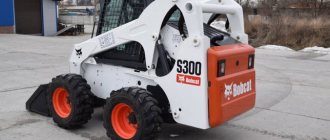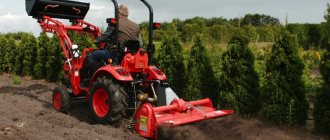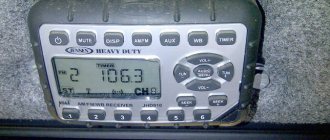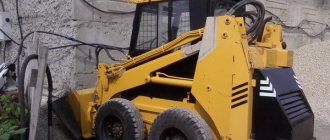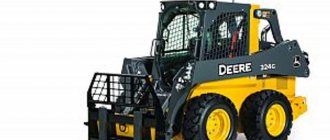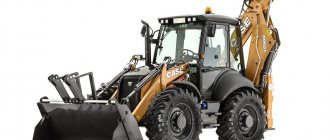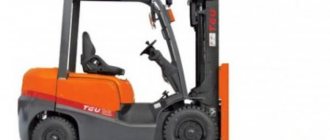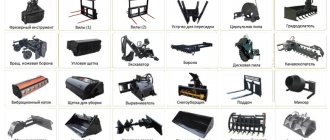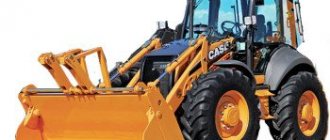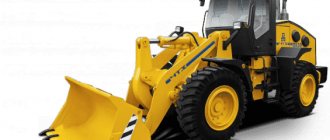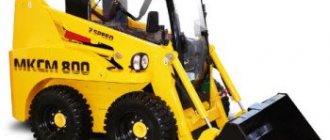In general, in production today, compact class loaders can differ in their type and design. The equipment can be a side-steer or a front-facing model. It should be noted that the name does not fully reflect the peculiarity of the equipment, since the machine is unique and is suitable for most industrial organizations, where it is primarily used as a carrier of equipment. In general, the choice of a forklift can be influenced by many factors, first of all you need to rely on the specifics of the job, and you should also take into account many other details.
What work will the equipment do?
As already mentioned, the most important thing is to decide on the tasks that the mini loader will need to perform, that is, it will be used:
- In construction.
- For laying utility networks.
- Road repair and maintenance.
- Maintenance of sidewalks.
Will the forklift perform one job or switch to different ones? Multi-functional use will require a machine equipped with more attachments and therefore a more complex and powerful hydraulic system. Typically, skid steer loaders have more efficient hydraulic systems. If we are talking primarily about lifting and transport work, a front loader is preferable because its transport speed is usually higher and the ride is smoother due to its longer wheelbase. It is believed that the maximum performance of skid steer loaders is achieved with a cargo transportation range of up to 25–30 m. If cargo is to be transported over long distances, it is better to choose a mini front loader.
Availability of a special quick-action adapter for connecting replaceable equipment
If the equipment will be used to change attachments, it must be equipped with a special quick-action adapter. This part is quite expensive, but thanks to it, productivity increases significantly. The higher the size of the skid steer, the more common a certain type of latch-to-pin adapter will be. For bucket and fork, the design is indispensable and shows excellent efficiency.
Operating the forklift in special conditions or in small spaces
As for the dimensions of the equipment and its maneuverability, it is important to take into account the place where the work will mainly be carried out. Today, skid steer loaders have the best maneuverability, as they can turn around on the spot. Although some still prefer the front knee technique, due to the fact that all the wheels there can be controlled. High-quality loaders are offered by Lonking and Bobcat.
Why are forklift buyers not ready to support the domestic manufacturer?
This will be a revelation for many, but Russia also produces forklifts. Domestic enterprises produce a total of about 4,000 units of equipment per year. Do you think it's a lot? Then compare with Chinese production - 100,000! What is the reason for such low performance? The answer is obvious. The wrong approach to the production process, and, dare I say it, the greed of our owners of factories that manufacture equipment, but this is simply unacceptable. In a world where an invisible war is raging between different equipment manufacturers, we simply cannot forget about the constant updating of production technologies, constant training of personnel, and tireless and very strict quality control of every detail. Recently, on the Internet, I accidentally read a dialogue between a Russian seller in a Chinese equipment showroom and a buyer. The client approached the seller with a question: whose equipment are they selling? To which the answer was: “Domestic and Chinese.” The buyer said a phrase that probably explains the lack of demand for domestic equipment: “I’m tired of ours, let’s do better than the Chinese.” This phrase clearly hints to Russian companies that it is time to keep up with the times; the current buyer wants not only a low price, but also high quality and functionality.
Author:
Vitaly Sermilin | Google Share article on social networks:
Maximum lifting capacity of equipment
When choosing a model, you need to pay attention to the maximum load capacity, and it is important to take a small reserve. This will allow you to get rid of unforeseen situations, that is, the cargo may end up with a larger mass. That is, this approach will completely eliminate prolonged operation at maximum capabilities, which will increase the service life of the loader and many of its elements.
This rule is best applied to other characteristics of equipment.
The lift rating listed on a skid steer determines the maximum weight the machine can safely lift. The rated capacity of a skid steer loader is 50% of the tipping load. The tipping load is defined as follows: the bucket is raised to its maximum height with maximum reach and begins to load when the rear wheel of the loader begins to lift off the ground, that is, it is ready to tip over - this is the tipping load. For a compact skid steer loader, the rated lift capacity is 35% of tipping load. For an articulated loader, the tipping load is determined with the half-frames folded as far as possible. You should be careful: the values of the rated load capacity that manufacturers give in the technical specifications of articulated loaders can be calculated based on the tipping load with the semi-frames in a straight position. In this case, the calculated value can be 15–20% greater than with the half-frames folded to the maximum. If an articulated forklift is equipped with a fork, the rated lift capacity may be only 35-40% of that of a forklift.
Where to choose
It should be noted that when choosing, you should not focus on one model. All possible options should be considered to ensure that the skid steer actually meets all the necessary requirements that the buyer expects. After all, only in this case, work processes will be carried out as quickly as possible and in the shortest possible time. And this in turn will mean that the work will be completed on time.
Source
Review of the JCB 180W mini loader. Pros and cons of the model.
Load lifting height
When choosing, it is important to pay attention to the operating mode of the equipment, that is, how much time per day the machine will be operated, what load will be placed on it. That is, under very high loads, it is recommended to focus on proven and high-quality manufacturers, which currently include Bobcat and Lonking. Although such models are expensive, you can be sure that they will last a long time, with proper care, of course. Before purchasing, it is best to even read the reviews of real customers, this will give you the opportunity to really evaluate the strengths of the chosen model. As for the capacity of the fuel tank, it is also better to find out immediately in order to know how many hours of continuous operation a certain amount of fuel will last. Every entrepreneur should understand that if this type of equipment is needed for a short period of time, then it would be more advisable to rent it rather than buy it. If it is needed on an ongoing basis, then the question disappears by itself. The market today offers a variety of models, adapted to very serious conditions, so there shouldn’t be any problems finding them.
EXPERT OPINION
Dmitry Kim, director of the marketing department of NTK Forklift LLC (www.ntk-forklift.ru):
– For the last few years, it has been supplying road construction equipment to the Russian market from Chinese manufacturers XGMA, Sunward and Forway. Our experience and feedback from partners confirm the fact that Chinese technology is an excellent combination of efficiency and productivity. The equipment we import has proven itself effectively in almost all regions of Russia, including extreme regions of Siberia, the Far East and the polar North. The machines operate at large construction sites, factories, and they are also building an important infrastructure facility in Sochi for the 2014 Olympic and Paralympic Games.
For our part, we are ready to dispel the prejudice that Chinese brands are not as reliable as European or Japanese ones. Each machine requires a professional approach and timely maintenance, regardless of the country in which it was produced. Treat your special equipment with due care, and it will serve you for many years.
Loader design type and features
Engine power
Skid-steer loaders require additional engine power (30-40% more than a skid steer loader with the same lift capacity) to generate higher hydraulic flow due to the undercarriage design. The presence of an articulated frame on a front loader does not place increased demands on engine power. A mini loader can have a diesel or gas engine. The advantages and disadvantages of both are known; gas is more environmentally friendly and costs less in terms of fuel, but it starts worse in the cold, so it is more preferable for working indoors. Engine power is very important if the skid steer must simultaneously move the load and power the tool when operating an attachment.
Tracked or wheeled vehicles?
For special conditions, a special machine is needed. Based on the characteristics of the coating, you should choose a wheeled or tracked loader. The latter option is excellent for use in damp environments or on soft soils, and also demonstrates excellent efficiency on uneven surfaces or steep slopes. Snow and ice, as you know, are not scary for caterpillars, and along with this, thick grass. The tape will provide maximum grip on absolutely any surface, while wheels on uneven surfaces cannot provide such a result. Often, skid steers are sent to unpaved sites due to the fact that they turn around with the wheels slipping. That is, even if the surface was initially smooth and comfortable, the on-board equipment may soon slip and get stuck in place. As a result, it will be necessary to spend a lot of time just to get the site into working condition. If we talk about tracked vehicles, they do not worsen the condition of the soil so much, thereby practically not creating ruts. Such a machine is characterized by excellent stability and even when working on wet ground, their carrying capacity will not be interrupted. At any time of the year and under any conditions, such equipment will work flawlessly. Of course, in light of all the features, a logical question arises: what about the shortcomings; unfortunately, they also exist.
- Low speed.
- High fuel consumption.
- Inflated costs for operating the chassis.
If we talk specifically about road work, then without any doubt, preference should be given to wheel loaders. Tires interact much better with hard surfaces, while tracks can damage it.
Since a mini track loader often operates in non-standard conditions, it can be equipped with additional equipment, most often a fuel or oil tank with increased capacity. Based on this, and also due to the costs of servicing the chassis, such equipment will cost much more than wheeled models.
When choosing wheeled and tracked vehicles, it is recommended to analyze the situation and answer a number of important questions:
- Will the wheeled equipment cope with all the planned work?
- Will it be possible to do all the work using a track loader and still increase productivity and make more profit?
- Will tracked vehicles be able to compensate for all costs, increase productivity and work off their high cost?
Such equipment is purchased in exceptional cases when wheeled equipment cannot cope with all types of work or is generally impractical to use. If the caterpillar may not be needed for a long time, then it is better to pay attention to a model with an optional kit of tracks or special metal belts that are mounted directly on the wheels.
Additional hydraulic circuits and power
If the skid steer is to be used with replaceable hydraulic equipment, the machine's hydraulic system must have sufficient power.
The hydraulic circuit intended to power an attachment is characterized by the amount of fluid flow and its pressure. These parameters are used to evaluate the ability of attachments to work with a given loader. The minimum permissible flow and pressure values are indicated in the characteristics of the hydraulic attachments. It is especially important to consider these parameters when it comes to a tool that consumes increased power. If the hydraulic system does not match the needs of the implement, it may operate but will not perform well.
As mentioned above, skid steer loaders have more powerful engines than wheel loaders of similar lifting capacity. The more powerful the forklift engine, the more powerful the hydraulic system. Light-duty skid-steer loaders have hydraulics that are not much more powerful than comparable front-end loaders, but the disparity in hydraulic performance increases as machine sizes get larger. However, many manufacturers offer options for front mini-loaders: a hydraulic system with increased productivity. Obviously, the presence of a powerful hydraulic system presupposes the presence of a powerful engine, which entails an increase in fuel consumption. The system must be equipped with additional circuits and connectors for connecting attachments. All skid steer loaders and most skid steer loaders have additional hydraulic circuits. Therefore, in most of these machines, additional hydraulic connectors are routed along the boom into a device for quickly connecting attachments. However, some front loaders in the basic configuration can only be “prepared” for the installation of additional hydraulic circuits: have an additional third section in the hydraulic distributor. If you have a backup valve section, installing an additional hydraulic circuit is usually easy, but it will require additional costs. It is also important to know what type of pump is used in the hydraulic system. Most hydraulic systems have an optional gear pump built into the standard hydraulic circuit to provide a continuously variable increase in flow at constant system pressure. This increases the speed of the attachment, but does not increase the force. The force can be increased by simultaneously increasing the flow and pressure in the hydraulic system. This principle of operation is used in high-power hydraulic systems with an adjustable piston pump, which explains their advantage.
Working conditions for the operator
The employee needs to be provided with the most comfortable place, for this purpose certain aspects should be assessed:
- Convenient entry and exit from the cabin.
- Noise insulation.
- Availability of a heating system.
- Air circulation in the cabin.
- Seat comfort and equipment placement.
- Easy to operate all levers.
- Are there any blind spots around the equipment?
- Is the edge of the bucket visible from the control position?
Most often, the cabin of a front-facing machine is much more spacious, which provides full visibility of the working area in any direction. Also here the steering is light.
Main Differences
Of course, the first thing you should pay due attention to is the suspension of the mini loader. It can be of two types:
Each side of such technology can be controlled independently of each other. When the axles rotate in different directions, the skid steer can spin around its own axis. It is for these positive qualities that many warehouse owners prefer it. After all, it can successfully maneuver even in the narrowest passages without any problems. All other differences are minor. These may include:
- Retractable boom shape;
- Ground clearance height;
- Availability of turn signals.
But they will not be able to optimize the work.
Cost of owning a compact loader
Front-mounted equipment is in great demand among European construction organizations, primarily due to the fact that fuel consumption is significantly lower compared to analogues. However, to make a proper comparison, you must analyze the total cost of ownership and operating costs over the projected life cycle of the forklift, including purchase, insurance, maintenance, and tire wear costs. Many experts say that under the same operating conditions, the cost of fuel and tire wear on a front-end mini-loader will be significantly less, but in general, in operation with the same rated load capacity, a front-end mini-loader, as a rule, costs about 15–30 more. %. But tires for front-end loaders can be more expensive than tires for skid-steer equipment. It is believed that front loaders demonstrate higher fuel efficiency also because their engines operate at partial load and low speed most of the time. In contrast, skid steer loaders often have the engine running at full power or at high rpm even when the power is not at full power.
The selling price of front-end vehicles, especially fairly powerful models, is often higher than a vehicle with the same load capacity, but with skid steer. In Russia, cost influences the choice, so many construction organizations here give preference to the second option. The inflated cost can also be explained by the fact that individual elements of equipment are much more expensive and their maintenance is correspondingly overpriced.
The service life of equipment directly depends on operating and maintenance conditions.
When it comes to skid steer loaders, they are most effective in the first six years, while a front-end model can operate without any problems for 10 years. This takes into account that the average operating time will be 1000 hours. Return to Articles section
Bobcat S530. With maintenance free transmission
Photo source: bobcatrussia.ru
Operating weight: 2,815 kg Power: 49.5 hp (36.4 kW)
The Bobcat S530, which replaced the popular S175 model, accounts for about 40% of the brand's mini loader sales in our country. This demand is due to the optimal load capacity and lifting height for Russian buyers: these indicators are 869 kg and 3,023 mm, respectively. In addition, customers often prefer a vertical boom lifting system.
The machines are equipped with Japanese Kubota 2203 engines (eco-class - Euro-3), most other components are produced in the USA and the Czech Republic. Among the Bobcat specialists' own developments, it is especially worth noting the transverse engine arrangement and maintenance-free transmission (both solutions are patented).
Photo source: bobcatrussia.ru
The Bobcat S530 skid steer operator's cab features a Deluxe design with foam interior lining, side, top and rear windows, accessory cabling, overhead lighting, power socket, front and rear work lights. The heating system, sprung seat, storage compartment and cup holder make the working conditions even more comfortable. And the ROPS/FOPS systems, as well as the seat belt and seat frame, help protect the operator from injury.
Standard equipment includes Bob-Tach™ frame, parking brake, automatic glow plug heater, muffler with spark arrestor, BICS, and emergency engine/hydraulic shutdown. Tires - 10x16.5, 10-ply, designed for severe operating conditions.
To connect attachments, front auxiliary hydraulics with electrical proportional control are provided. The accuracy of operations is ensured by a bucket positioning system (complete with a switch) and standard instrumentation.
The S530 mini loader is capable of moving at speeds of up to 18 km/h. The overall dimensions of the machine are 3,378x1,727x1,972 mm, the volume of a standard bucket is 0.4 cubic meters.
Electro-hydraulic controls
One of the most important advances in skid steer technology has been the use of electro-hydraulic controls, which are now the norm and a powerful enabler of automated technology. This type of control system was developed in response to consumer requests.
The latest technologies developed around electro-hydraulic control systems provide benefits such as the ability to switch between different control modes: that is, quickly switch from lever and pedal control to H-joystick control or ISO control.
Electro-hydraulic control also allows the operator to configure some machine operating parameters, such as the speed of response of the transmission and hydraulic equipment to control commands, the intensity of acceleration of the mini-loader, the maximum speed of the mini-loader and speed adjustment regardless of the engine speed (this is convenient when working some types of attachments), adjusting the crawl mode settings and enabling automatic steering correction to compensate for machine deviation from the specified path of movement when, as a result of using some types of implements, the loader moves away from the correct direction of travel. In addition, you can adjust the working cycle time: adjusting the speed of the boom and bucket. This allows you to adapt the performance characteristics of the machine to the conditions of specific work.
The use of electro-hydraulic controls on Caterpillar allows owners to customize performance settings based on personal preference and the type of job being performed. For example, you can enable Precision Control Mode, which modulates (decreases) travel speed for more precise fork positioning of loads or increases it for high-capacity bucket work.
Yes, in fashion. The Cat 918M is programmable to limit boom and implement lift to a specified height. Now operators can simply press a touch button on the screen to program the position and lift height of the work equipment and return the implement to its previous position using a button on the joystick. Operators will appreciate the end-of-stroke cylinder piston damping system, which acts as a brake to slow the movement of the loader boom and arms before they stop at a programmed position.
The transition to electro-hydraulic control facilitates the operator’s work by automating and reducing manual control operations: it provides the ability to automatically level the bucket and other working tools during raising and lowering the boom, implementing a programmable function “return to the digging position”, “return the boom to the lower transport position” load” and settings for the positioning of working tools when performing repetitive operations such as leveling, digging and loading, automatically with minimal operator participation and qualifications. Moving the joystick lever becomes smoother and easier, the operator can literally control numerous machine functions with just his fingers, resulting in less fatigue. As a result, working time is saved and the machine and operator operate with greater productivity and profitability.
Case recently introduced new G Series compact wheel loader models with electro-hydraulic controls. The system includes more than 20 sensors and 20 electrohydraulic actuators. The company claims that this new technology will improve the operator's control of the machine, provide the ability to select different operating modes of the machine, and provide the machine with the ability to perform multiple movements simultaneously. The use of automatic functions reduces operator fatigue and increases productivity even for inexperienced operators.
Case has taken proven electro-hydraulic control technologies that have proven successful on Case G Series full-size wheel loaders and adapted them for use on these compact models. In addition, the G Series compact wheel loaders feature seven additional patented innovations. The series is planned to go into production during 2022.
Case has also introduced electro-hydraulic controls on its compact F-Series wheel loaders.
